The Spatial Effects of Regional Poverty: Spatial Dependence, Spatial Heterogeneity and Scale Effects
Abstract
:1. Introduction
1.1. The Spatial Dependence of Regional Poverty
1.2. The Spatial Heterogeneity of Regional Poverty
1.3. The Scale Effects of Regional Poverty
2. Material and Methods
2.1. Study Region
2.2. Geographical Factors and the Data Sources
| Dimensions | Description | Indicators | Abbreviations | Data Sources |
|---|---|---|---|---|
| First nature geography | Physical conditions | Average elevation (m) | AE | ALOS DSM: Global 30 m (2014) [52] |
| Annual average precipitation (mm) | AAP | Resource and Environment Science and Data Center (2014) (https://www.resdc.cn/Default.aspx, accessed on 20 January 2022) | ||
| Annual average temperature (°C) | AVT | |||
| Proportion of the population impacted by natural disasters (%) | PPN | China Geological Survey (average data from last 10 years) (https://geocloud.cgs.gov.cn/, accessed on 20 January 2022) | ||
| Per capita cropland (ha per capita) | PCC | Copernicus Global Land Cover Layers: CGLS-LC100 collection (2015)/Land-use and land-cover change provided by Yunyang government (2014) | ||
| Natural resources | Cropland with slope higher than 15° (%) | CSH | Copernicus Global Land Cover Layers: CGLS-LC100 collection (2015)/Land-use and land-cover change provided by Yunyang government (2014)Department of natural resources of Hubei Province (2015) (http://zrzyt.hubei.gov.cn/fbjd/xxgkml/sjfb/kczytjsj/#test, accessed on 20 January 2022)/POI data from Gaode map API (2014) | |
| Per capita value of mine resources (county level/township level)/Distance to the nearest mineral site (village level) | PCM | |||
| Farmland production potential | FPP | (http://www.resdc.cn/, accessed on 20 January 2022), 2017. DOI:10.12078/2017122301 | ||
| Second nature geography | Geolocation and transportation | Density of roads (m/km2) | DR | Road network from local government and interpretation of Google Maps (2014) |
| Distance to nearest train station (m) | DNT | POI data from Gaode map API (2014)/Harvard University world map (https://dataverse.harvard.edu/dataverse/chgis, accessed on 20 January 2022) (2016)/ | ||
| Distance to the nearest central city/county (county/township level)/Average time cost from residential area in the village to the nearest town (min) (village level) | DCI/DCO/ATT | Statistic year book of Hubei (2014)/POI data from Gaode map API (2014) | ||
| Third nature geography | Governance capability of local government | Per capita local financial revenue (county level/township level)/no data at village level | PCF | Statistic year book of Hubei (2014) |
| The investment attracted (%) (county level)/no data at village level | IA | Annual assessment report on county economic work in Hubei Province in 2014 | ||
| informatization level | Proportion of the population having access to the internet (%) | PPI | Annual assessment report on county economic work in Hubei Province (2014)/Household census data provided by the local government (2017) | |
| Public service | Number of registered doctors per 10,000 people | NRD | Hubei health and family planning yearbook (2014)/Household census data provided by the local government (2014) | |
| Number of registered teachers per 10,000 people (county level)/township level/Access to the nearest school (min) (village level) | NRT/AS | Hubei education yearbook (2014)/POI data from Gaode map (2014) | ||
| Proportion of New Rural Co-operative Medical System participants (%) | PMP | Annual assessment report on county economic work in Hubei Province in 2014 | ||
| Proportion of labor force (%) | PLF | Hubei agriculture yearbook (2014)/Household census data provided by the local government (2017) | ||
| Human resources | Proportion of migrant labor force (%) | PMLF | Hubei agriculture yearbook (2014)/Household census data provided by the local government (2017)WorldPop (www.worldpop.org) (21 September 2023) [53] | |
| Proportion of aged 60 or above (%) | PA | Hubei agriculture yearbook (2014)/Household census data provided by the local government (2017)WorldPop (www.worldpop.org) (21 September 2023) [53] | ||
| Average educational attainment of people | AEA | 2010 population census of the PRC |
2.3. Methods
2.3.1. Spatial Autocorrelation Analysis for Spatial Dependency
2.3.2. Variable Importance Metrics for Global Spatial Heterogeneity Analysis
2.3.3. Multiscale Geographically Weighted Regression (MGWR) for Local Spatial Heterogeneity Analysis
2.3.4. Handling Multicollinearity and Model Selection
3. Results
3.1. The Spatial Effects of Regional Poverty at Multiple Scales
3.2. The Spatial Effects of Regional Poverty Determinants at Multiple Scales
3.2.1. The Global Spatial Heterogeneity of Regional Poverty at Multiple Scales
The Impact of Geographical Factors on Poverty at Multiple Levels
The Neighboring Effects at Multiple Levels
3.2.2. The Local Spatial Heterogeneity of Regional Poverty Determinants at Multiple Scales
4. Discussion
4.1. Spatial Effects of Regional Poverty
4.2. Policy Implications
4.3. Limitations
5. Conclusions
Supplementary Materials
Author Contributions
Funding
Data Availability Statement
Conflicts of Interest
References
- Carter, D.J.; Glaziou, P.; Lönnroth, K.; Siroka, A.; Floyd, K.; Weil, D.; Raviglione, M.; Houben, R.M.; Boccia, D. The impact of social protection and poverty elimination on global tuberculosis incidence: A statistical modelling analysis of Sustainable Development Goal 1. Lancet Glob. Health 2018, 6, e514–e522. [Google Scholar] [CrossRef]
- Lakner, C.; Mahler, D.G.; Negre, M.; Prydz, E.B. How much does reducing inequality matter for global poverty? J. Econ. Inequal. 2022, 20, 559–585. [Google Scholar] [CrossRef] [PubMed]
- Bruckner, B.; Hubacek, K.; Shan, Y.; Zhong, H.; Feng, K. Impacts of poverty alleviation on national and global carbon emissions. Nat. Sustain. 2022, 5, 311–320. [Google Scholar] [CrossRef]
- Puttanapong, N.; Martinez, A., Jr.; Bulan, J.A.N.; Addawe, M.; Durante, R.L.; Martillan, M. Predicting poverty using geospatial data in Thailand. ISPRS Int. J. Geo-Inf. 2022, 11, 293. [Google Scholar] [CrossRef]
- Liu, Y.; Liu, J.; Zhou, Y. Spatio-temporal patterns of rural poverty in China and targeted poverty alleviation strategies. J. Rural. Stud. 2017, 52, 66–75. [Google Scholar] [CrossRef]
- Moyer, J.D.; Verhagen, W.; Mapes, B.; Bohl, D.K.; Xiong, Y.; Yang, V.; McNeil, K.; Solórzano, J.; Irfan, M.; Carter, C. How many people is the COVID-19 pandemic pushing into poverty? A long-term forecast to 2050 with alternative scenarios. PLoS ONE 2022, 17, e0270846. [Google Scholar] [CrossRef] [PubMed]
- Liu, M.; Ge, Y.; Hu, S.; Stein, A.; Ren, Z. The spatial–temporal variation of poverty determinants. Spat. Stat. 2022, 50, 100631. [Google Scholar] [CrossRef]
- Ge, Y.; Jin, Y.; Stein, A.; Chen, Y.; Wang, J.; Wang, J.; Cheng, Q.; Bai, H.; Liu, M.; Atkinson, P.M. Principles and methods of scaling geospatial Earth science data. Earth Sci. Rev. 2019, 197, 102897. [Google Scholar] [CrossRef]
- Poverty & Equity Data Portal. 2020. Available online: https://povertydata.worldbank.org/country_dashboard.aspx?code= (accessed on 22 September 2023).
- Tatem, A.; Gething, P.; Pezzulo, C.; Weiss, D.; Bhatt, S. Development of Pilot High-Resolution Gridded Poverty Surfaces (Methods Working Paper); University of Southampton/Oxford: Southampton, UK, 2013; Volume 9. [Google Scholar]
- Voss, P.R.; Long, D.D.; Hammer, R.B.; Friedman, S. County child poverty rates in the US: A spatial regression approach. Popul. Res. Policy Rev. 2006, 25, 369–391. [Google Scholar] [CrossRef]
- Marcinko, C.L.; Samanta, S.; Basu, O.; Harfoot, A.; Hornby, D.D.; Hutton, C.W.; Pal, S.; Watmough, G.R. Earth observation and geospatial data can predict the relative distribution of village level poverty in the Sundarban Biosphere Reserve, India. J. Environ. Manag. 2022, 313, 114950. [Google Scholar] [CrossRef]
- Maden, S.I.; Baykul, A. New Trends in Social, Humanities and Administrative Sciences, 1st ed.; Duvar Publishing: Izmir, Turkey, 2022; pp. 89–104. [Google Scholar]
- Arouri, M.; Nguyen, C.; Youssef, A.B. Natural disasters, household welfare, and resilience: Evidence from rural Vietnam. World Dev. 2015, 70, 59–77. [Google Scholar] [CrossRef]
- Hu, S.; Ge, Y.; Liu, M.; Ren, Z.; Zhang, X. Village-level poverty identification using machine learning, high-resolution images, and geospatial data. Int. J. Appl. Earth Obs. Geoinf. 2022, 107, 102694. [Google Scholar] [CrossRef]
- Liu, M.; Hu, S.; Ge, Y.; Heuvelink, G.B.; Ren, Z.; Huang, X. Using multiple linear regression and random forests to identify spatial poverty determinants in rural China. Spat. Stat. 2021, 42, 100461. [Google Scholar] [CrossRef]
- Okwi, P.O.; Ndeng’e, G.; Kristjanson, P.; Arunga, M.; Notenbaert, A.; Omolo, A.; Henninger, N.; Benson, T.; Kariuki, P.; Owuor, J. Spatial determinants of poverty in rural Kenya. Proc. Natl. Acad. Sci. USA 2007, 104, 16769–16774. [Google Scholar] [CrossRef] [PubMed]
- Pokhriyal, N.; Jacques, D.C. Combining disparate data sources for improved poverty prediction and mapping. Proc. Natl. Acad. Sci. USA 2017, 114, E9783–E9792. [Google Scholar] [CrossRef]
- Putri, S.R.; Wijayanto, A.W.; Sakti, A.D. Developing relative spatial poverty index using integrated remote sensing and geospatial big data approach: A case study of east java, Indonesia. ISPRS Int. J. Geo-Inf. 2022, 11, 275. [Google Scholar] [CrossRef]
- Ma Zhenbang, J.Z.; Chang, G.; Su, X.; Chen, X. Spatial Dependence, Spatial Variation and Scale Effect in the Formation of Rural Poverty Pattern. Econ. Geogr. 2022, 42, 210–221. [Google Scholar]
- Durlauf, S.N. The Memberships Theory of Poverty: The Role of Group Affiliations in Determining Socioeconomic; University of Wisconsin–Madison: Madison, WI, USA, 2001. [Google Scholar]
- Fang, Y.; Zou, W. Neighborhood effects and regional poverty traps in rural China. China World Econ. 2014, 22, 83–102. [Google Scholar] [CrossRef]
- Ge, Y.; Yuan, Y.; Hu, S.; Ren, Z.; Wu, Y. Space–time variability analysis of poverty alleviation performance in China’s poverty-stricken areas. Spat. Stat. 2017, 21, 460–474. [Google Scholar] [CrossRef]
- Ravallion, M. On measuring global poverty. Annu. Rev. Econom. 2020, 12, 167–188. [Google Scholar] [CrossRef]
- Rodriguez-Oreggia, E.; De La Fuente, A.; De La Torre, R.; Moreno, H.A. Natural disasters, human development and poverty at the municipal level in Mexico. J. Dev. Stud. 2013, 49, 442–455. [Google Scholar] [CrossRef]
- Ward, J.; Kaczan, D. Challenging Hydrological Panaceas: Water poverty governance accounting for spatial scale in the Niger River Basin. J. Hydrol. 2014, 519, 2501–2514. [Google Scholar] [CrossRef]
- Kam, S.-P.; Hossain, M.; Bose, M.L.; Villano, L.S. Spatial patterns of rural poverty and their relationship with welfare-influencing factors in Bangladesh. Food Policy 2005, 30, 551–567. [Google Scholar] [CrossRef]
- Benson, T.; Chamberlin, J.; Rhinehart, I. An investigation of the spatial determinants of the local prevalence of poverty in rural Malawi. Food Policy 2005, 30, 532–550. [Google Scholar] [CrossRef]
- Ren, Z.; Ge, Y.; Wang, J.; Mao, J.; Zhang, Q. Understanding the inconsistent relationships between socioeconomic factors and poverty incidence across contiguous poverty-stricken regions in China: Multilevel modelling. Spat. Stat. 2017, 21, 406–420. [Google Scholar] [CrossRef]
- Watmough, G.R.; Atkinson, P.M.; Saikia, A.; Hutton, C.W. Understanding the Evidence Base for Poverty–Environment Relationships using Remotely Sensed Satellite Data: An Example from Assam, India. World Dev. 2016, 78, 188–203. [Google Scholar] [CrossRef]
- Salvacion, A.R. Spatial pattern and determinants of village level poverty in Marinduque Island, Philippines. GeoJournal 2018, 85, 257–267. [Google Scholar] [CrossRef]
- Kim, R.; Mohanty, S.K.; Subramanian, S.V. Multilevel Geographies of Poverty in India. World Dev. 2016, 87, 349–359. [Google Scholar] [CrossRef]
- Ma, Z.; Chen, X.; Chen, H. Multi-scale spatial patterns and influencing factors of rural poverty: A case study in the Liupan Mountain Region, Gansu Province, China. Chin. Geogr. Sci. 2018, 28, 296–312. [Google Scholar] [CrossRef]
- Wang, B.; Tian, J.; Yang, P.; He, B. Multi-Scale Features of Regional Poverty and the Impact of Geographic Capital: A Case Study of Yanbian Korean Autonomous Prefecture in Jilin Province, China. Land 2021, 10, 1406. [Google Scholar] [CrossRef]
- Wang, Y.; Jiang, Y.; Yin, D.; Liang, C.; Duan, F. Examining multilevel poverty-causing factors in poor villages: A hierarchical spatial regression model. Appl. Spat. Anal. Policy 2021, 14, 969–998. [Google Scholar] [CrossRef]
- Pradhan, J.; Ray, S.; Nielsen, M.O.; Himanshu. Prevalence and correlates of multidimensional child poverty in India during 2015–2021: A multilevel analysis. PLoS ONE 2022, 17, e0279241. [Google Scholar] [CrossRef] [PubMed]
- Shu, D. China’s Uniquely Effective Approach to Poverty Alleviation. Adv. Appl. Sociol. 2022, 12, 205–218. [Google Scholar] [CrossRef]
- Wang, H.; Zhao, Q.; Bai, Y.; Zhang, L.; Yu, X. Poverty and subjective poverty in rural China. Social Indic. Res. 2020, 150, 219–242. [Google Scholar] [CrossRef]
- Ge, Y.; Liu, M.; Hu, S.; Wang, D.; Wang, J.; Wang, X.; Qader, S.; Cleary, E.; Tatem, A.J.; Lai, S. Who and which regions are at high risk of returning to poverty during the COVID-19 pandemic? Humanit. Soc. Sci. Commun. 2022, 9, 183. [Google Scholar] [CrossRef]
- Ge, Y.; Ren, Z.; Fu, Y. Understanding the relationship between dominant geo-environmental factors and rural poverty in Guizhou, China. ISPRS Int. J. Geo-Inf. 2021, 10, 270. [Google Scholar] [CrossRef]
- Krugman, P.R. First Nature, Second Nature, and Metropolitan Location. J. Reg. Sci 1991, 33, 129–144. [Google Scholar] [CrossRef]
- Qing-Chun, L.; Zheng, W. Research on geographical elements of economic difference in China. Geogr. Res. 2009, 28, 430–440. [Google Scholar]
- Wang, Z.; Geng, W.; Xia, H.; Wu, J.; Liu, Q. Geographical basis assessment of regional development and its construction of index system. Acta Geogr. Sin. 2023, 78, 558–571. [Google Scholar]
- Luo, Y.; Yan, J.; McClure, S.C.; Li, F. Socioeconomic and environmental factors of poverty in China using geographically weighted random forest regression model. Environ. Sci. Pollut. Res. Int. 2022, 29, 33205–33217. [Google Scholar] [CrossRef]
- Adebanji, A.; Achia, T.; Ngetich, R.; Owino, J.; Wangombe, A. Spatial Durbin model for poverty mapping and analysis. J. Eur. J. Soc. Sci. 2008, 5, 194–204. [Google Scholar]
- Watmough, G.R.; Atkinson, P.M.; Hutton, C.W. Predicting socioeconomic conditions from satellite sensor data in rural developing countries: A case study using female literacy in Assam, India. Appl. Geogr. 2013, 44, 192–200. [Google Scholar] [CrossRef]
- Blumenstock, J.; Cadamuro, G.; On, R. Predicting poverty and wealth from mobile phone metadata. Science 2015, 350, 1073–1076. [Google Scholar] [CrossRef]
- Sedda, L.; Tatem, A.J.; Morley, D.W.; Atkinson, P.M.; Wardrop, N.A.; Pezzulo, C.; Sorichetta, A.; Kuleszo, J.; Rogers, D.J.J.I.H. Poverty, health and satellite-derived vegetation indices: Their inter-spatial relationship in West Africa. Int. Health 2015, 7, 99–106. [Google Scholar] [CrossRef] [PubMed]
- Nashwari, I.P.; Rustiadi, E.; Siregar, H.; Juanda, B.J.T.I.J.O.G. Geographically Weighted Regression Model for Poverty Analysis in Jambi Province. Indones. J. Geogr. 2017, 49, 42. [Google Scholar] [CrossRef]
- Zhou, Y.; Liu, Y. The geography of poverty: Review and research prospects. J. Rural. Stud. 2019, 93, 408–416. [Google Scholar] [CrossRef]
- Liu, Y.; Li, J. Geographic detection and optimizing decision of the differentiation mechanism of rural poverty in China. Acta Geogr. Sin. 2017, 72, 161–173. [Google Scholar]
- Tadono, T.; Ishida, H.; Oda, F.; Naito, S.; Minakawa, K.; Iwamoto, H. Precise global DEM generation by ALOS PRISM. ISPRS Ann. Photogramm. Remote Sens. Spat. Inf. Sci. 2014, 2, 71. [Google Scholar] [CrossRef]
- Lloyd, C.T.; Chamberlain, H.; Kerr, D.; Yetman, G.; Pistolesi, L.; Stevens, F.R.; Gaughan, A.E.; Nieves, J.J.; Hornby, G.; MacManus, K. Global spatio-temporally harmonised datasets for producing high-resolution gridded population distribution datasets. Big Earth Data 2019, 3, 108–139. [Google Scholar] [CrossRef]
- Moran, P.A. Notes on continuous stochastic phenomena. Biometrika 1950, 37, 17–23. [Google Scholar] [CrossRef]
- Cliff, A.D.; Ord, J.K. Spatial Processes: Models & Applications; Taylor & Francis: New York, NY, USA, 1981. [Google Scholar]
- Anselin, L. Local indicators of spatial association—LISA. Geogr. Anal. 1995, 27, 93–115. [Google Scholar] [CrossRef]
- Grömping, U. Variable importance in regression models. Wiley Interdiscip. Rev. Comput. Stat. 2015, 7, 137–152. [Google Scholar] [CrossRef]
- McMillen, D.P. Issues in spatial data analysis. J. Reg. Sci 2010, 50, 119–141. [Google Scholar] [CrossRef]
- Kruskal, W. Relative importance by averaging over orderings. Am. Stat. 1987, 41, 6–10. [Google Scholar]
- Grömping, U. Estimators of relative importance in linear regression based on variance decomposition. Am. Stat. 2007, 61, 139–147. [Google Scholar] [CrossRef]
- Johnson, J.W.; LeBreton, J.M. History and use of relative importance indices in organizational research. Organ. Res. Methods 2004, 7, 238–257. [Google Scholar] [CrossRef]
- Lafary, E.W.; Gatrell, J.D.; Jensen, R.R. People, pixels and weights in Vanderburgh County, Indiana: Toward a new urban geography of human–environment interactions. Geocarto Int. 2008, 23, 53–66. [Google Scholar] [CrossRef]
- Xu, Z.; Cai, Z.; Wu, S.; Huang, X.; Liu, J.; Sun, J.; Su, S.; Weng, M. Identifying the Geographic Indicators of Poverty Using Geographically Weighted Regression: A Case Study from Qiandongnan Miao and Dong Autonomous Prefecture, Guizhou, China. Soc. Indic. Res. 2018, 142, 947–970. [Google Scholar] [CrossRef]
- Franke, G.R. Multicollinearity. In Wiley International Encyclopedia of Marketing; John Wiley & Sons: Hoboken, NJ, USA, 2010. [Google Scholar]
- Lachniet, M.S.; Patterson, W.P. Use of correlation and stepwise regression to evaluate physical controls on the stable isotope values of Panamanian rain and surface waters. J. Hydrol. 2006, 324, 115–140. [Google Scholar] [CrossRef]
- Cleveland, W.S.; Devlin, S.J. Locally weighted regression: An approach to regression analysis by local fitting. J. Am. Stat. Assoc. 1988, 83, 596–610. [Google Scholar] [CrossRef]
- Mahembe, E.; Odhiambo, N.M. Foreign aid, poverty and economic growth in developing countries: A dynamic panel data causality analysis. Cogent Econ. Financ. 2019, 7, 1626321. [Google Scholar] [CrossRef]
- Tilak, J.B. Education and poverty. J. Hum. Dev. 2002, 3, 191–207. [Google Scholar] [CrossRef]
- Gohou, G.; Soumaré, I. Does foreign direct investment reduce poverty in Africa and are there regional differences? World Dev. 2012, 40, 75–95. [Google Scholar] [CrossRef]
- Steele, J.E.; Sundsoy, P.R.; Pezzulo, C.; Alegana, V.A.; Bird, T.J.; Blumenstock, J.; Bjelland, J.; Engo-Monsen, K.; de Montjoye, Y.A.; Iqbal, A.M.; et al. Mapping poverty using mobile phone and satellite data. J. R. Soc. Interface 2017, 14, 20160690. [Google Scholar] [CrossRef]
- Amara, M.; Ayadi, M. The local geographies of welfare in Tunisia: Does neighbourhood matter? Int. J. Soc. Welf. 2013, 22, 90–103. [Google Scholar] [CrossRef]
- Farrow, A.; Larrea, C.; Hyman, G.; Lema, G. Exploring the spatial variation of food poverty in Ecuador. Food Policy 2005, 30, 510–531. [Google Scholar] [CrossRef]
- Fernando, L.; Surendra, A.; Lokanathan, S.; Gomez, T. Predicting population-level socio-economic characteristics using Call Detail Records (CDRs) in Sri Lanka. In Proceedings of the Fourth International Workshop on Data Science for Macro-Modeling with Financial and Economic Datasets-DSMM’18, Houston, TX, USA, 15 June 2018; Association for Computing Machinery: New York, NY, USA, 2018; pp. 1–12. [Google Scholar]
- Givoni, M. Development and impact of the modern high-speed train: A review. Transp. Rev. 2006, 26, 593–611. [Google Scholar] [CrossRef]

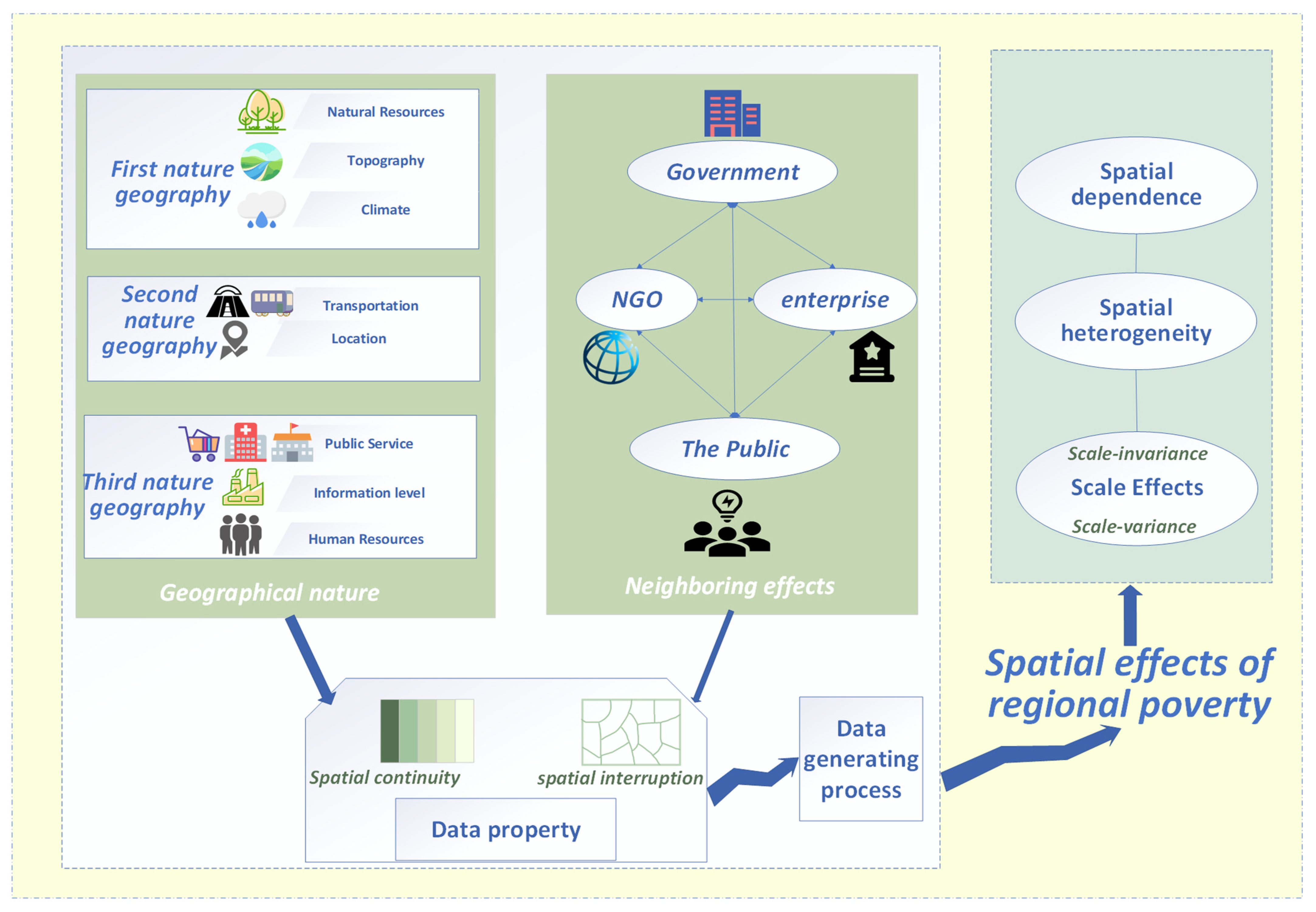

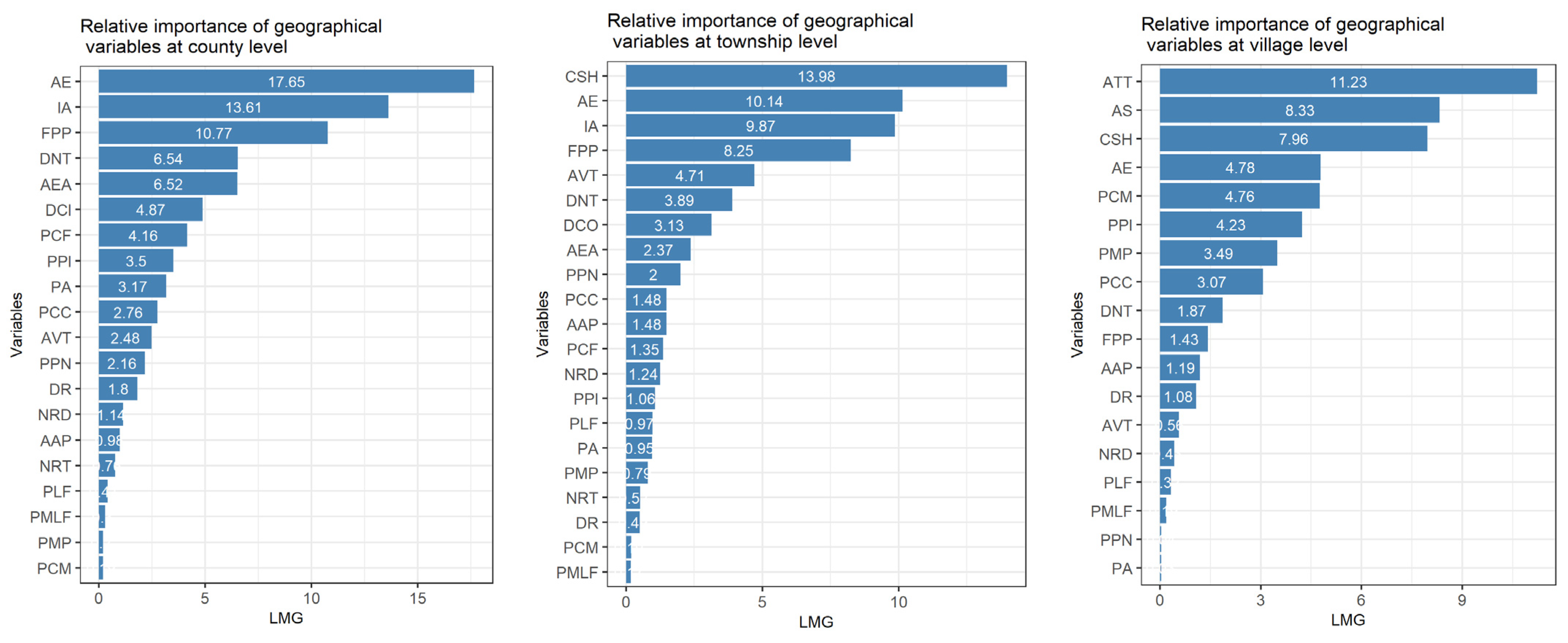
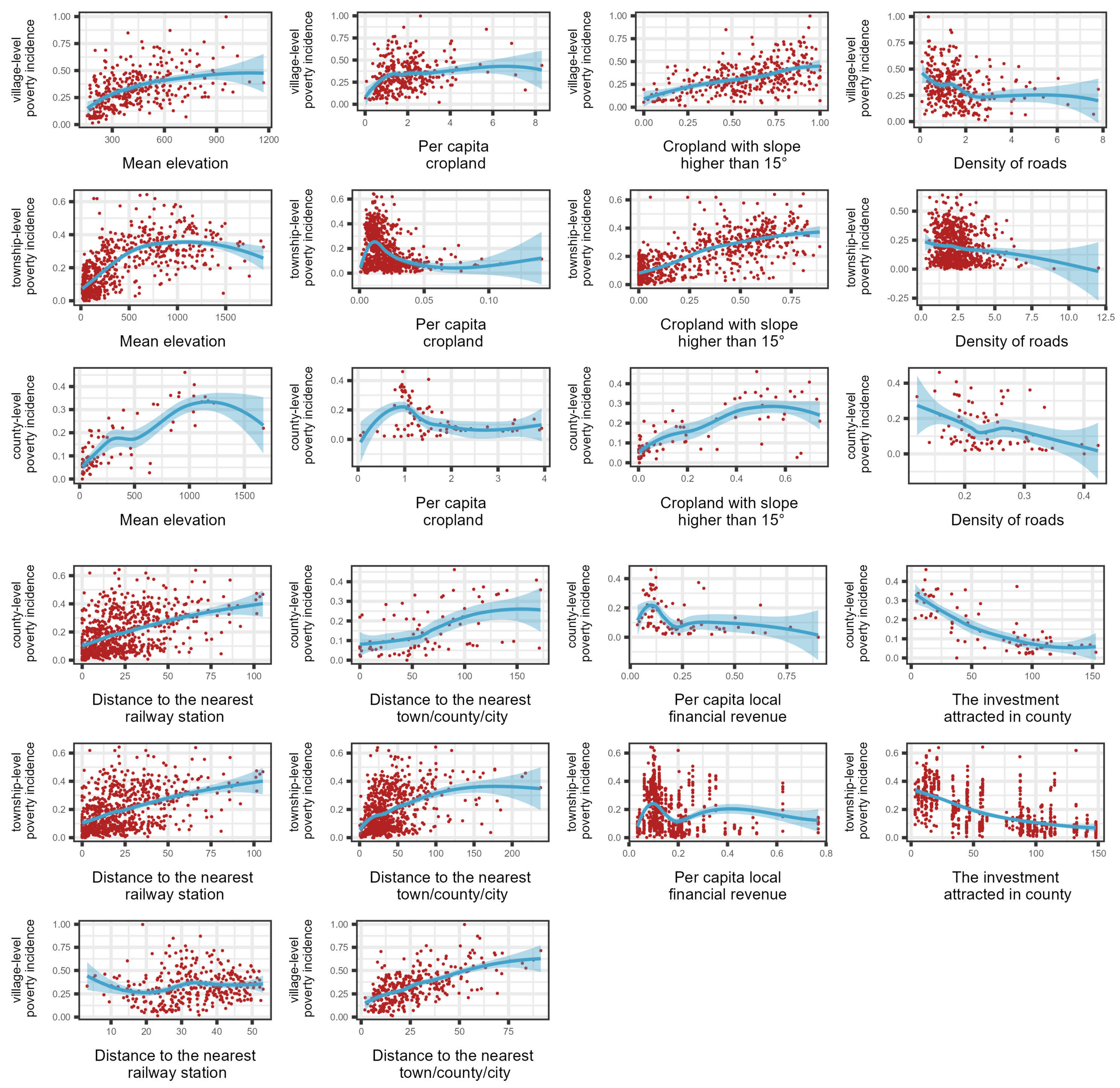
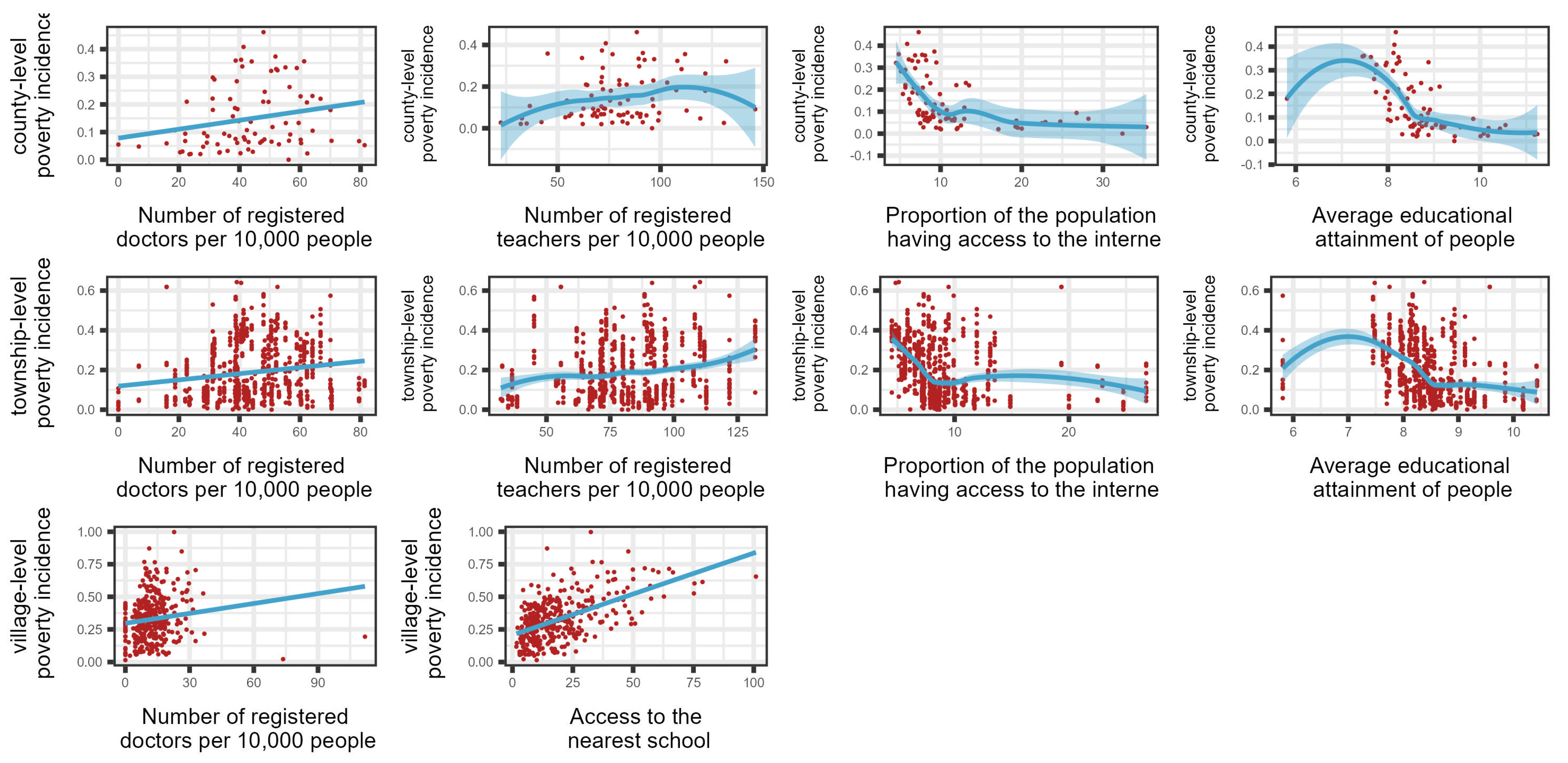
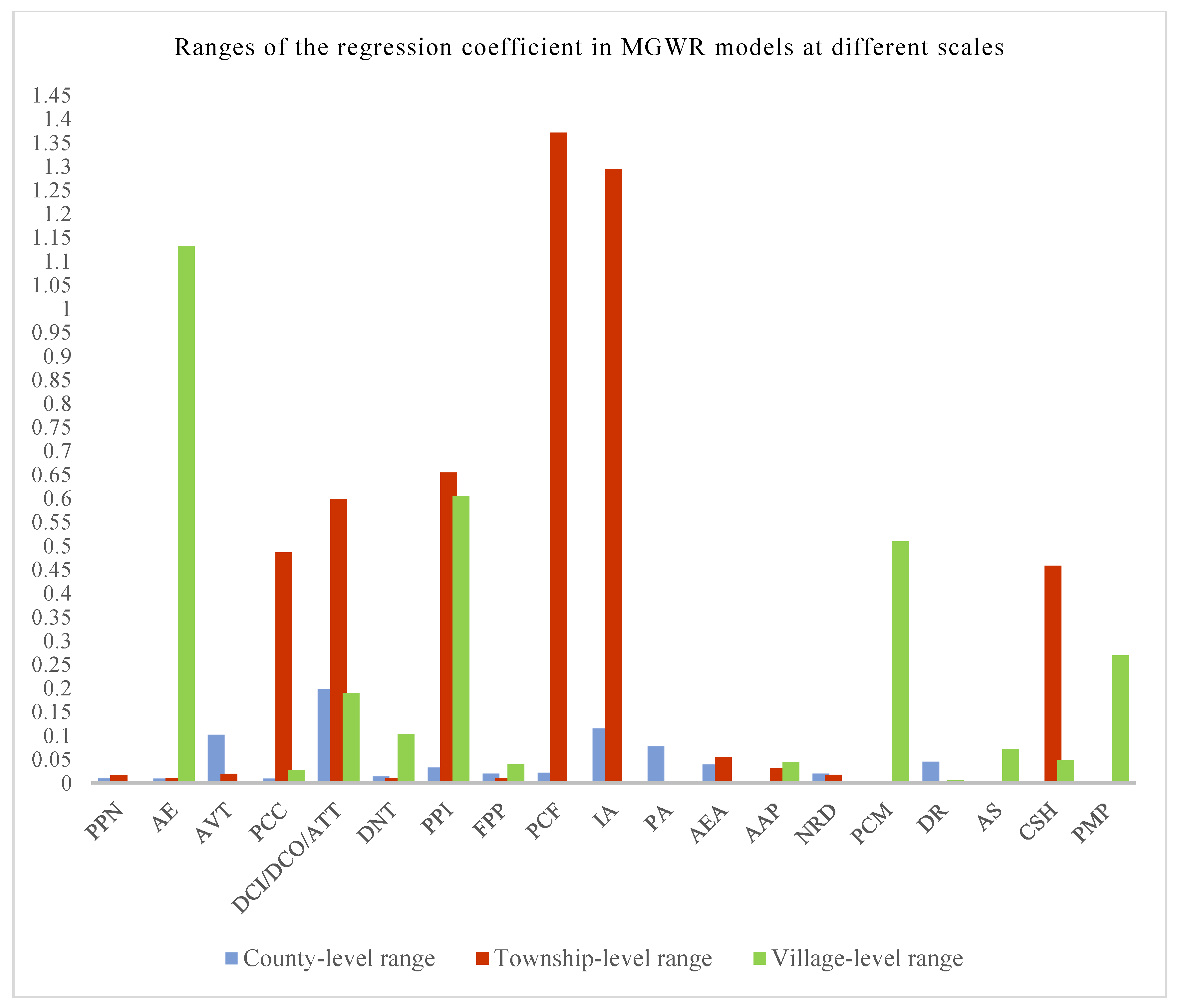
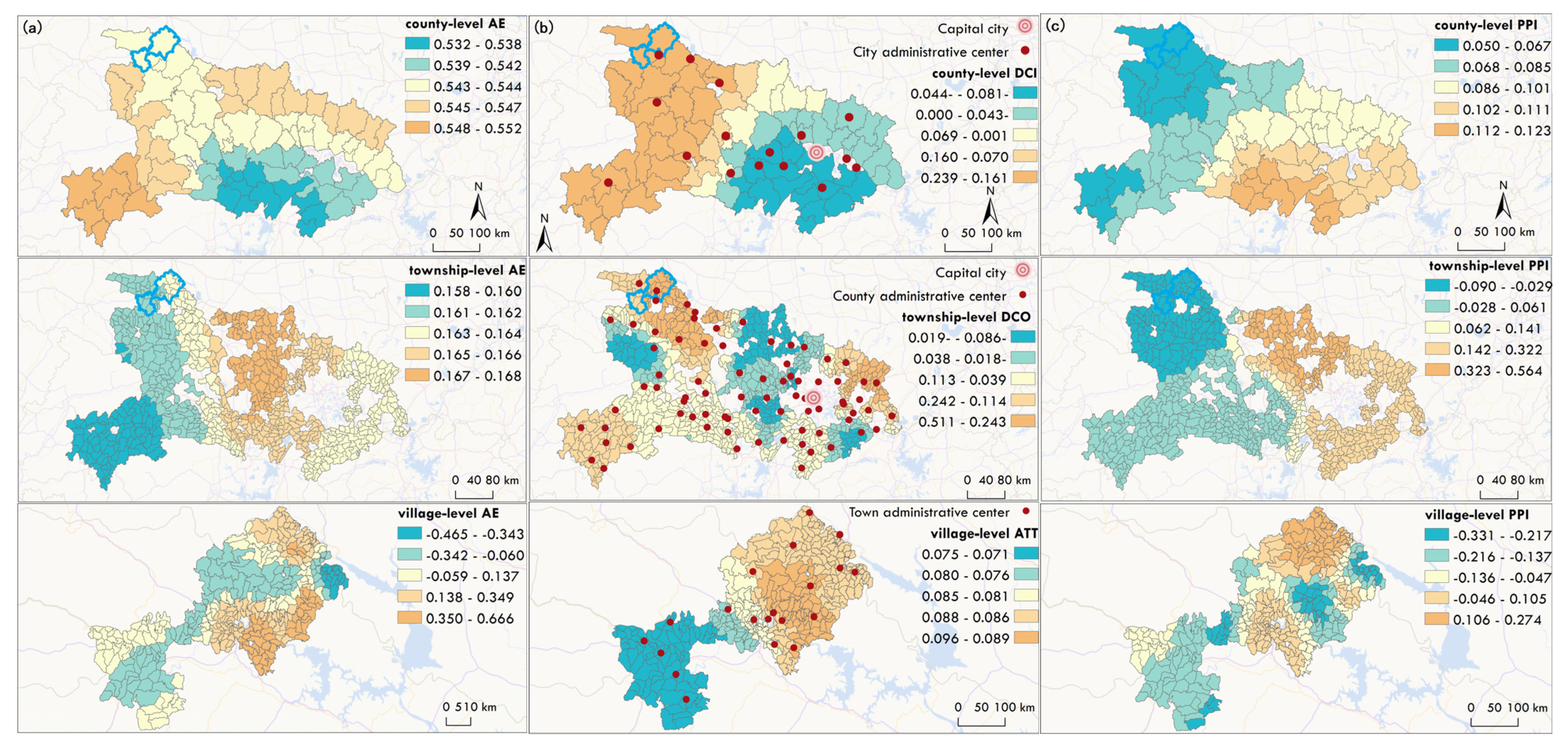
| County Level | Township Level | Village Level | |
|---|---|---|---|
| Moran’s Index | 0.67 *** | 0.66 *** | 0.44 *** |
| Variance | 0.071 | 0.019 | 0.001 |
| Z-score | 9.67 | 35.33 | 12.73 |
| County Level | Township Level | Village Level | |
|---|---|---|---|
| Adjusted R2 | 0.84 | 0.69 | 0.55 |
| RMSE | 3.93 | 0.076 | 0.11 |
| F-statistic | 22.43 *** | 85.2 *** | 23.87 *** |
| Administrative Levels | Administrative Levels | ||||||
|---|---|---|---|---|---|---|---|
| Variable | County (n = 91) | Township (n = 770) | Village (n = 341) | Variable | County (n = 91) | Township (n = 770) | Village (n = 341) |
| PPN | 0.615 *** | 0.552 *** | 0.058 | PLF | 0.132 | 0.071 | 0.045 |
| AE | 0.739 *** | 0.719 *** | 0.484 *** | PA | 0.459 *** | 0.239 *** | 0.086 |
| AVT | −0.306 ** | −0.428 *** | 0.027 | PMLF | −0.015 | 0.003 | 0.071 |
| AAP | 0.012 | −0.138 *** | 0.073 | PMP | −0.016 | −0.169 *** | 0.285 *** |
| PCC | −0.276 * | −0.295 *** | 0.285 *** | NRD | 0.263 * | 0.196 *** | 0.240 *** |
| FPP | −0.689 *** | −0.676 *** | 0.279 | NRT | 0.240 * | 0.199 *** | (AS) 0.508 *** |
| PCM | 0.367 *** | 0.018 | 0.379 *** | PPI | −0.647 *** | −0.401 *** | −0.450 *** |
| CSH | 0.720 *** | 0.729 *** | 0.487 *** | IA | −0.741 *** | −0.667 *** | |
| DR | −0.386 *** | −0.122 *** | −0.265 *** | AEA | −0.690 *** | −0.474 *** | |
| DNT | 0.518 *** | 0.441 *** | 0.190 *** | PCF | −0.498 *** | −0.204 *** | |
| DCI/DCO/ATT | 0.539 *** | 0.367 *** | 0.569 *** | ||||
| Administrative Level | Overall Contribution (%) | First Nature Geography | Second Nature Geography | Third Nature Geography | ||||
|---|---|---|---|---|---|---|---|---|
| Physical Condition | Natural Endowments | Geolocation and Transportation | Governance Capability | Informatization Level | Public Service | Human Resources | ||
| County level | 84 | 23.27 | 13.72 | 13.21 | 17.77 | 3.5 | 2.1 | 10.4 |
| Township level | 69 | 18.33 | 23.9 | 7.51 | 11.22 | 1.06 | 2.55 | 4.46 |
| Village level | 55 | 6.57 | 17.22 | 14.18 | 0 | 4.23 | 12.25 | 0.54 |
| County | Township | Village | |
|---|---|---|---|
| Moran’s Index | −0.0692 | 0.228 | 0.0580 |
| Expected Index | −0.0122 | −0.0013 | −0.0030 |
| Variance | 0.0738 | 0.0246 | 0.0338 |
| Z-score | −0.7785 | 9.2885 | 1.777 |
| County Level | Township Level | Village Level | |
|---|---|---|---|
| Adjusted R2 | 0.90 | 0.81 | 0.65 |
| Residual sum of squares | 5.23 | 124.23 | 104.11 |
| County Level | Township Level | Village Level | ||||
|---|---|---|---|---|---|---|
| Variable | Mean | Bandwidth | Mean | Bandwidth | Mean | Bandwidth |
| PPN | −0.186 | 89 | −0.047 | 768 | - | - |
| AE | 0.543 | 89 | 0.163 | 768 | 0.087 | 58 |
| AVT | −0.076 | 89 | −0.101 | 768 | - | - |
| PCC | 0.065 | 89 | 0.188 | 154 | 0.179 | 346 |
| DCI/DCO/ATT | 0.094 | 52 | 0.092 | 109 | 0.153 | 179 |
| DNT | 0.094 | 89 | 0.148 | 768 | −0.001 | 346 |
| PPI | 0.09 | 89 | 0.122 | 252 | −0.077 | 79 |
| FPP | −0.067 | 89 | −0.046 | 768 | −0.122 | 346 |
| PCF | −0.105 | 89 | −0.001 | 46 | - | - |
| IA | −0.28 | 54 | −0.348 | 44 | - | - |
| PA | −0.019 | 73 | - | - | ||
| AEA | −0.181 | 89 | −0.058 | 732 | - | - |
| AAP | - | - | 0.007 | 768 | 0.078 | 346 |
| NRD | 0.006 | 89 | 0.014 | 768 | - | - |
| PCM | - | - | - | - | 0.218 | 186 |
| DR | −0.026 | 77 | - | - | −0.008 | 346 |
| AS | - | - | - | - | 0.186 | 346 |
| CSH | - | - | 0.312 | 146 | 0.142 | 346 |
| PMP | - | - | - | - | 0.219 | 268 |
Disclaimer/Publisher’s Note: The statements, opinions and data contained in all publications are solely those of the individual author(s) and contributor(s) and not of MDPI and/or the editor(s). MDPI and/or the editor(s) disclaim responsibility for any injury to people or property resulting from any ideas, methods, instructions or products referred to in the content. |
© 2023 by the authors. Licensee MDPI, Basel, Switzerland. This article is an open access article distributed under the terms and conditions of the Creative Commons Attribution (CC BY) license (https://creativecommons.org/licenses/by/4.0/).
Share and Cite
Liu, M.; Ge, Y.; Hu, S.; Hao, H. The Spatial Effects of Regional Poverty: Spatial Dependence, Spatial Heterogeneity and Scale Effects. ISPRS Int. J. Geo-Inf. 2023, 12, 501. https://doi.org/10.3390/ijgi12120501
Liu M, Ge Y, Hu S, Hao H. The Spatial Effects of Regional Poverty: Spatial Dependence, Spatial Heterogeneity and Scale Effects. ISPRS International Journal of Geo-Information. 2023; 12(12):501. https://doi.org/10.3390/ijgi12120501
Chicago/Turabian StyleLiu, Mengxiao, Yong Ge, Shan Hu, and Haiguang Hao. 2023. "The Spatial Effects of Regional Poverty: Spatial Dependence, Spatial Heterogeneity and Scale Effects" ISPRS International Journal of Geo-Information 12, no. 12: 501. https://doi.org/10.3390/ijgi12120501






